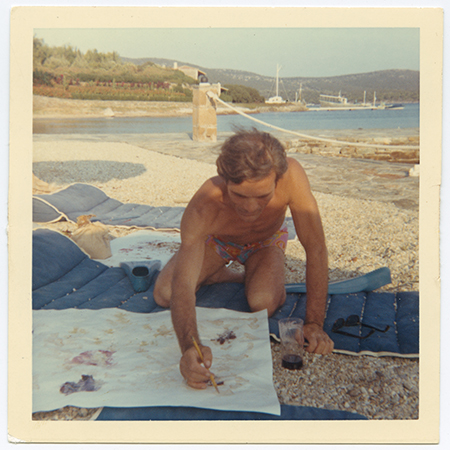Pasolini Roma

Perennially centred upon the city, exhibitions at the Centre de Cultura Contemporània de Barcelona represent objects through creative, often interpretive installations. The exhibition ‘The City of K’ (2002–03), for example, offered up not merely Franz Kafka’s manuscripts or first editions, but assemblages, installations and projections. ‘Pasolini Roma’, curated by Alain Bergala, Jordi Balló and Gianni Borgna, continued along similar lines. Poet, journalist, novelist, film director, dramatist, painter and polemicist, Pier Paolo Pasolini practically redefined interdisciplinarity in the wake of Italy’s own postwar reinvention.
Fired from his job as a teacher following a charge of corrupting minors, and kicked out of the Communist party, by 1950 Pasolini was living with his mother in Rome’s borgata – the squalid shantytowns lining the city’s edges. It was from these coarse denizens that Pasolini distilled a refined aesthetic brew: steeped equally in fin-de-siècle decadence, the legacy of Neorealist cinema and the writings of the late, martyred Communist theorist Antonio Gramsci. Pasolini’s murder on the beach at Ostia in 1975 at the hands of a hustler matched the scandalous vitality that marked his life in Rome. The paradoxes of his oeuvre – its confusing admixtures of materiality and metaphysics – resist any simple recapitulation. This exhibition navigated those ironies deftly.
Successive rooms treated periods chronologically, each prefaced by a video taken from a contemporary locale in Rome, shot specifically for the show. While it included actual manuscripts, the exhibition resisted passive display. One room featured a patinated copy of the sculpted Turtle Fountain from Rome’s Piazza Mattei, juxtaposed with Pasolini’s poetry-in-prose writing from Le notti calde (Hot Nights, 1950) and accompanied by footage of that year’s Jubilee pilgrimages to St. Peter’s Cathedral – an event Pasolini deemed exemplary of ‘a colourless religion’. Likewise, a section dedicated to his book of poems, The Ashes of Gramsci (1957), featured a replica of Gramsci’s tomb from the ‘Non-Catholic’ cemetery of Rome, along with a recording of Pasolini reading his own verse aloud. A sizeable cross-section of his drawings and paintings gave a good sense of his affinity for this medium, which he studied under art historian Roberto Longhi. A room of paintings by Pasolini’s contemporaries – from Giorgio Morandi and Filippo De Pisis, to Renato Guttuso and Mario Mafai – conjured up the poles of withdrawal and commitment that nourished his own aesthetic vision.
Pasolini’s transformations of Neorealism’s legacy in his films such as Accattone (1961) and Mamma Roma (1962), meanwhile, came alive through creative installations. The subject of more than 30 separate trials in his lifetime, Pasolini found himself on the witness stand as frequently as in his director’s chair or at his desk. A wall of newspaper clippings and photographs – flanked by a replica of his montage table with which he screened La Ricotta (1962) during one such trial – conveyed something of the artist’s struggles against censorship. By contrast, the lighthearted obverse of his work – such as the 1965 documentary Love Meetings – appeared enlivened to the same degree, projected here on the dashboard of a Fiat 1100, in which the director traversed the country while making the film.
Centred as it was upon Rome’s influence on Pasolini’s work, the exhibition lost something of its thread as it proceeded further afield, whether in Palestine/Matera, Africa or India. The later adaptations of the ‘Trilogy of Life’ (The Decameron, 1971; The Canterbury Tales, 1972; and A Thousand and One Nights, 1974) likewise leave behind not only Rome, but also the explicit contemporaneity of his first, post-Neorealist efforts. To be sure, the curators made a case for the enduring rapport of Pasolini’s later work in Rome. Indeed, even as he travelled to more exotic locales, Pasolini remarked ‘the third world begins on Rome’s periphery’.
The exhibition’s final rooms closed on an elegiac note. A fragment of Nanni Moretti’s 1993 film Caro Diario (Dear Diary), during which the director stops at a monument to Pasolini in Ostia, evoked just how much the director’s unredeemed ghost still haunts Italy: still defying a reactionary and racist right, but also prodding an ineffectual left into self-questioning. After a century and a half of its modern incarnation, Italy’s ‘Third Rome’ – after that of the caesars and the popes – remains up for grabs, having eluded Fascism and the Resistance alike. If the Eternal City seems increasingly submitted to the Postmodern cynicism of Silvio Berlusconi, it is to Pasolini’s example that a new resistance consistently turns in struggling against it.
















